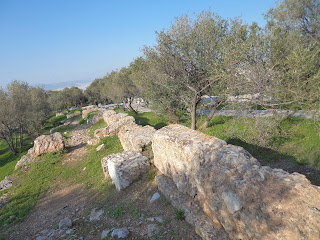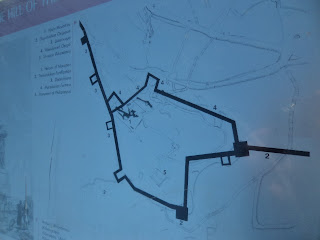Also called the Hill of Muses, Filoppapou Hill - along with the Hills of the Pnyx and the Nymphs - was according to Plutarch, where Theseus and Amazons did battle. Inhabited from the prehistoric times to the post Byzantine era, today the pine-clad slopes are a relaxing place for a stroll. They offer excellent views of Attica and the Saronic Gulf, well signed ruins and some of the very best vantage points for photographing Acropolis.
The hill, to the southwest of the Acropolis is identifiable by the monument of Filopappos, crowing its summit, it was built between AD114 and AD116 in the honor of Julius Antiochus Filopappos, a prominent Roman consul and administrator. The paved path to the top starts near the kiosk (periptero) on Dionysiou Areopagitou street. After 250 meters, it passes the excellent church of Agios Dimitrios Loumbardiaris, which contains fine frescoes, and continues past Socrates' prison, the Shrine of the Muses and on up to the top.
(Description of Filopappos hill given by the Guide of Lonely Planet Greece, page 75).
EPIC PHILOPAPPOS 02
HILL OF THE MUSES – PHILOPAPPOS
HILL OF THE MUSES – PHILOPAPPOS
According
to the traveler Pausanias (200 AD), the highest of the three West Hills took
its name from the Poet Musaeus (Mousaios) who lived, taught, and was buried
there. The square northeast of the summit of the hill, formed by carving in the
natural rock, and with niches on its west with statue bases, benches, and an
offering table, is attributed to the Heroon of Musaeus.
The
prominent and dominant position of the Hill of the Muses across from the
Acropolis was in mythical times the Athenians' bulwark against the Amazones.
Historically it has been used as a fortification of vital strategic importance
in major military operations.
In the 500
A.D., the Athenians included this hill in the Themistoclean fortifications, and
in the 400 A.D. they cited the Diateichisma
at its summit. In 294 A.D., Demetrius Poliocretes incorporated a small
fort known as a Macedonian Fortress in the old walls and stationed a garrison
there to control the city.
In the 200
A.D., the funerary monument of Gaius Julius Antiochus Philopappos (Philopappus)
, a prince from Commagene in Upper Syria and a benefactor of Athens, was built
at the summit of the Hill of the Muses, since then, this monumental has
dominated the landscape and imposed the name of its builder on the hill itself.
The
monument, which was build of Pentelic marble, rises atop a pores crepis to a
height of 12 m. Its monumental curving facade, which faces to Acropolis, is
divided in two zones. In the upper zone, three deep niches were formed: In the
central niche is the (now) headless statue of an enthroned Philopappos, and
beneath the staue the inscription "Philopappos, son of the Epiphanes of
the deme of the Besa".
In the left
hand niche, his grandfather Antiochus was depicted, as noted on the inscription
beneath the figure: "King Antiochus, son of King Antiochus". In the right-hand niche, which is missing
today, the founder of the Seleucid dynasty was portrayed: "King Seleucus
Nicator, son of Antiochus", according to the inscription preserved down to
15th century. In the lower zone there is a frieze with the representation of
the Philopappos on a quadriga framed by lictors. On the rear side of the
monument was the burial chamber in the form of a naiskos that held Philopappos'
sarcophagus. The monument was preserved intact until the 15th century, but was
gradually destroyed by acts and vandalism and natural phenomena. It was
partially restored in 1904 by the engineer N.Balanos.
(Text from Navigating the Routes of Art and Culture, written by O.Dakoura - Vogiatzoglou / Hellenic Republic Ministry of Culture).
(Text from Navigating the Routes of Art and Culture, written by O.Dakoura - Vogiatzoglou / Hellenic Republic Ministry of Culture).
EPIC O3 - PHILOPAPPOS
Wikipedia
The Philopappu Monument (Greek: Μνημείο Φιλοπάππου) is an ancient Greek mausoleum and monument dedicated to Gaius Julius Antiochus Epiphanes Philopappos or Philopappus, (Greek: Γάιος Ιούλιος Αντίοχος Επιφανής Φιλόπαππος, 65–116 AD), a prince from the Kingdom of Commagene. It is located on Mouseion Hill in Athens, Greece, southwest of the Acropolis.
Origins
Philopappos died in 116, and his death caused great grief to his sister Julia Balbilla, citizens of Athens and possibly to the imperial family. As a dedication to honor the memory of Philopappos, Balbilla with the citizens of Athens erected a tomb structure on Muse Hill (Lofos Muson) near the Acropolis of Athens. His marble tomb monument is still known as the Philopappu Monument, and the hill is today known as Philopappu Hill (Λόφος Φιλοπάππου).
The Greek geographer Pausanias (Description of Greece, I.25.8), describes Philopappos’ grand tomb as a monument built for a Syrian man. The monument was built on the same site where Musaios or Musaeus, a 6th-century BC priestly poet and mystical seer, was held to have been buried. The location of this tomb, opposite the Acropolis and within formal boundaries of the city, shows the high position Philopappos had within Athenian society.
Description
Philopappos’ monument is a two-storey structure, supported by a base. On the lower level there is a frieze representing Philopappos as a consul, riding on a chariot and led by lictors. The upper level shows statues of three men: of Antiochus IV on the left, of Philopappos in the centre and of Seleucus I Nicator, now lost, on the right.
In the niche below Philopappos is an inscription in Greek: Φιλόπαππος Επιφάνους Βησαιεύς ("Philopappos, son of Epiphanes of the deme of the Besa"). This was the name Philopappos carried as an Athenian citizen. In the niche left of Philopappos, a Latin inscription records Philopappos’ titles, honors and his career as a Roman magistrate: "Caius Iulius Antiochus Philopappos, son of Caius, of the Fabian tribe, consul and Arval brother, admitted to the praetorian rank by the emperor Caesar Nerva Trajan Optimus Augustus Germanicus Dacicus". On the right niche of Philopappos once stood a Greek inscription (now only the base is preserved): Βασιλεύς Αντίοχος Φιλόπαππος Βασιλέως Επιφανούς Αντιόχου ("King Antiochus Philopappos, son of King Antiochus Epiphanes").
Below the statue of Antiochus IV, Philopappos' paternal grandfather, is an inscription that states "King Antiochus son of King Antiochus". This inscription honors Antiochus IV and his late father, the last independent ruler of the Kingdom of Commagene, King Antiochus III Epiphanes. When Antiochus III died in 17, Commagene was annexed by the Roman Emperor Tiberius and became a part of the Roman Empire. Below the statue of Seleucus I, the founder of the Seleucid Empire from whom the Commagene kings claimed descent, stood another inscription, now lost. The traveller Cyriacus of Ancona wrote in his memoir that underneath the inscription stated "King Seleucus Nicator, son of Antiochus".
The monument measures 9.80 by 9.30 metres (32.2 ft × 30.5 ft), and contains Philopappos’ burial chamber. The structure is built of white Pentelic marble on a socle 3.08 metres (10.1 ft) high, made of porous marble and veneered with slabs of Hymettian marble. The north side of Philopappos’ monument bears lavish architectural decorations.
Excavations and history
In 1898, excavations were carried out at the monument and in 1899 conservation work was undertaken. In 1940, archaeologists H. A. Thompson and J. Travlos conducted small additional excavations. Recent investigations have certified that architectural parts of Philopappos’ Monument were used for construction of the Minaret in the Parthenon.
Only two-thirds of the façade remains. The tomb chamber behind the façade is completely destroyed except for the base. The Philopappos Monument was apparently still intact in 1436, when the traveller Ciriaco de' Pizzicolli visited the monument and wrote in his memoirs that the monument was still intact. The destruction of the monument must have occurred after this time.
The Philopappou movement
The year 2002 saw the rise of a movement in Athens to defend the natural character of what the people call Philopappou Hill, where the Philopappos Monument is located.
With an area of 173 acres (70 ha), which was declared an archaeological park in 1955-56, it is first and foremost the home of indigenous birds, including the Athenian owl and the peregrine falcon, as well as an important stop-over for many migratory birds, amounting to a total of about 94 different species. It also has a community of land tortoises, bats and a large variety of plant species. Philopappou Hill includes: the Hill of the Muses, the Hill of the Nymphs, and the Pnyx, the latter being of great historical importance, as it was the meeting place of democratic legislatures in ancient times.
The park is likewise known for the beautiful landscaping and stone pathways created by architect Dimitris Pikionis, who also restored the 16th-century Byzantine chapel of Saint Dimitrios [Loumbardiaris] in 1954-58. In 1996 the Ministry of Culture declared the works of Pikionis a monument of contemporary architecture. They are also listed by UNESCO as a protected monument of cultural heritage. For more than 10 years the residents of the neighbourhoods surrounding the Hill have challenged the plans of the Ministry of Culture to fence the entire 173 acres and restrict access by imposing visiting hours and an entrance fee.
It is to this day the belief of the movement that the best protection for the hill is guaranteed by the love, care and active participation of the local people. As a result of their tenacity, the largest and most naturally beautiful public space in Athens remains free and open to all, day and night.
























































































Δεν υπάρχουν σχόλια:
Δημοσίευση σχολίου
Σημείωση: Μόνο ένα μέλος αυτού του ιστολογίου μπορεί να αναρτήσει σχόλιο.